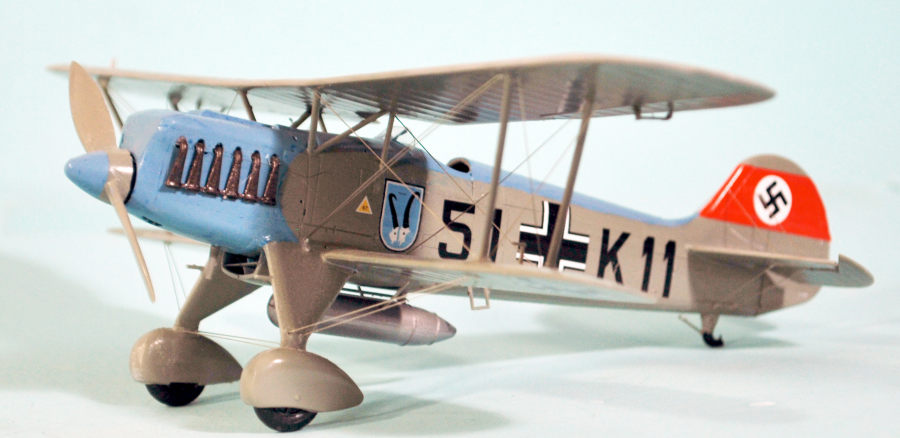
Roden 1/48 He-51B-1
| KIT #: | 452 |
| PRICE: | $25 - 30.00 |
| DECALS: | Two options |
| REVIEWER: | Tom Cleaver |
| NOTES: | Aeromaster 48-456 |

| HISTORY |
There is a saying in aviation design that, "if it looks right, it is right." While this is generally true, it was unfortunately not the case as regards the Heinkel He-51, which was a completely orthodox biplane of undistinguished performance, though this was primarily due to the failure of the German aircraft industry of the period to develop suitable high-performance engines as was happening in Great Britain at Rolls-Royce. Had the He-51 been powered by a Kestrel, like its contemporary the Hawker Fury, things might have been different, even if it was nowhere near as maneuverable as that famous classic.
What was important about the He-51 from a design standpoint was its elegance of line, being the first design to come from the aestheic of designer Walter Gunter; complemented by the mathematic genius of his twin brother Siegfried, these two would provide the indelible hallmark "look" of Heinkel aircraft of the Thirties.
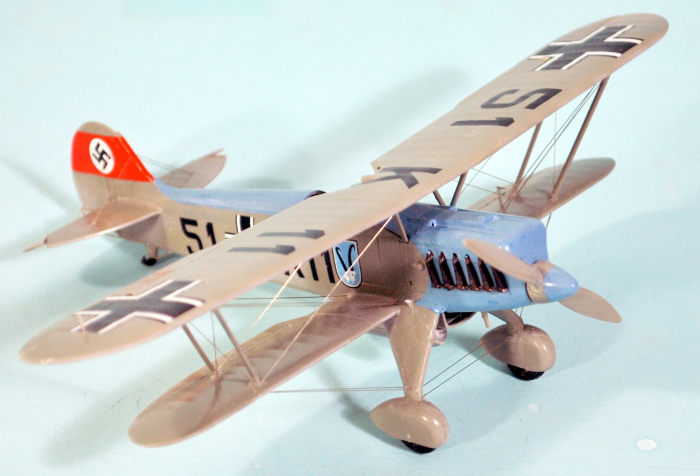 The
airplane first appeared as the He-51a. The
Technischen Amt of the
Luftfahrtkommisariat became interested when it was
revealed it had a higher performance than the Arado Ar-65E which was
planned as the first fighter equipment of the still-secret
Luftwaffe, with the same BMW 6.0 ZU engine;
this fighter promised performance that would equal the international
standard.
The
airplane first appeared as the He-51a. The
Technischen Amt of the
Luftfahrtkommisariat became interested when it was
revealed it had a higher performance than the Arado Ar-65E which was
planned as the first fighter equipment of the still-secret
Luftwaffe, with the same BMW 6.0 ZU engine;
this fighter promised performance that would equal the international
standard.
Introduced into service as the He-51A-0, the fighter equipped the DVL Reklame-Staffel Mitteldeutschland, the "Central Germany Publicity Squadron," which would later become known as II/JG.132 "Richtofen" when the Luftwaffe was revealed to the rest of Europe in 1935. Early accidents were laid to deficiencies in training rather than anything intrinsic to the design.
The He-51B differed from its predecessor in having twin-wire bracing of the landing gear, and the ability to carry a 50-liter drop tank beneath the fuselage. As production proliferated in 1936-37, so did the Jagdgeschwader mounted on the elegant-looking fighter, with their colorful unit markings.
The beginning of the end for the He-51 came in January 1936. The Luftwaffefuhrungsstab considered that the Arado Ar-68 offered little over the Heinkel in terms of performance and questioned putting it into production. Ernst Udet, Inspector of Fighter and Dive Bomber Pilots, decided to resolve the question. Mounted in the Ar-68E, with a very experienced pilot in an He-51, Udet out-climbed, out-dove and out-maneuvered the Heinkel fighter with ease. Beginning in 1937, the Jagdgruppen were re-equipped with the Ar-68.
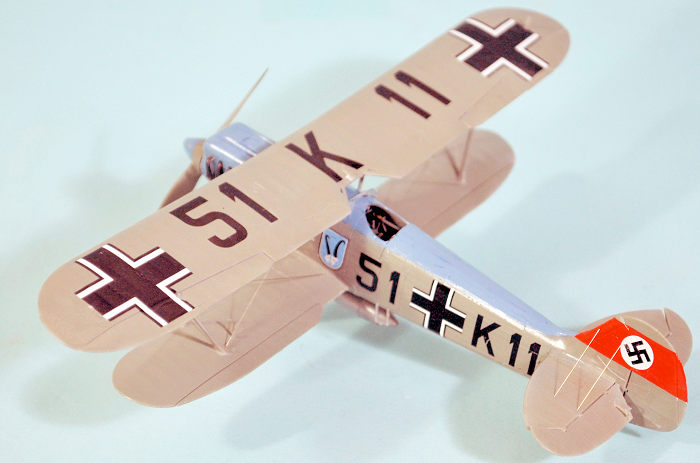 I/JG
135 was formed out of Bruno Loerzer’s Jagdgruppe
Bernberg in March 1937, based at Bad Aibling and
commander by Major Max Ibel. By that summer the
Staffelkapitänen included Hannes Trautloft and
Dietrich Hrabak, both newly returned from Spain. The unit selected as
its gruppe symbol the “Kitzbüheler Gams”
(Kitzbühel Goat), which live in the Kitzbühel Alps, a mountain range in
the Austrian Tyrol. The unit participated in the Anschluss in 1938 and
pilots from the former Austrian Luftkreitskraft
(air force) joined the gruppe. The unit traded the outclassed He-51s for
Ar-68E-1 over the summer of 1938; II/JG 135 had been the first unit to
equip with the Ar-68 in 1937, flying the Ar-68F.
I/JG
135 was formed out of Bruno Loerzer’s Jagdgruppe
Bernberg in March 1937, based at Bad Aibling and
commander by Major Max Ibel. By that summer the
Staffelkapitänen included Hannes Trautloft and
Dietrich Hrabak, both newly returned from Spain. The unit selected as
its gruppe symbol the “Kitzbüheler Gams”
(Kitzbühel Goat), which live in the Kitzbühel Alps, a mountain range in
the Austrian Tyrol. The unit participated in the Anschluss in 1938 and
pilots from the former Austrian Luftkreitskraft
(air force) joined the gruppe. The unit traded the outclassed He-51s for
Ar-68E-1 over the summer of 1938; II/JG 135 had been the first unit to
equip with the Ar-68 in 1937, flying the Ar-68F.
In retrospect, the failure of the He-51 when it was bested by the Ar-68 and then when it entered combat in Spain was ultimately a good thing for the Luftwaffe, since it forced the service to bring the Messerschmitt Bf-109 into operational use far earlier than would otherwise have been the case, subjecting that great design to the pressure of wartime development from the beginning of its career, and assuring it of the ascendancy it would hold when war finally broke out in Europe three years later. As well, the early introduction of the Bf-109 into combat forced the pilots of the Luftwaffe to abandon the useless formations and tactics of the biplane era, and create tactics and formations appropriate to a high-speed fighter; this would mean they could out fly their enemies for at least the first two years of the Second World War, since their opponents still used the outmoded tactics.
| THE KIT |
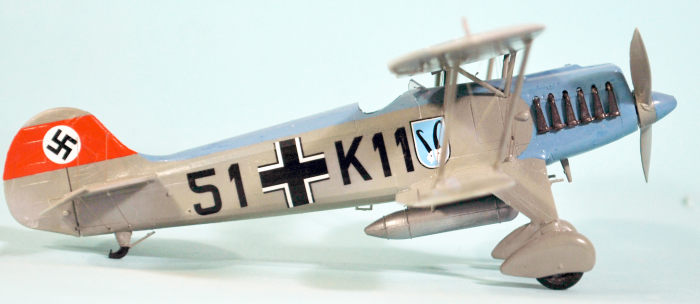 Roden’s
He-51 appeared in the summer of 2015 and is the first mainstream
injection-molded kit of this airplane in 1/48 scale. Classic Airframes
released two different attempts at the airplane as limited run kits back in
1996. For those who still have that kit, this kit far outshines it.
Roden’s
He-51 appeared in the summer of 2015 and is the first mainstream
injection-molded kit of this airplane in 1/48 scale. Classic Airframes
released two different attempts at the airplane as limited run kits back in
1996. For those who still have that kit, this kit far outshines it.
The kit has beautiful restrained fabric surface detail, and a fully detailed cockpit. The cabane and interplane struts are appropriately thin. The one-piece wings are commendably thin.
The decals are the usual Roden so-so affair and are better replaced with aftermarket decals.
I have found that while Aeromaster decals are long out of print, they are readily available on eBay for prices that are not out of line with the price of contemporary aftermarket decals. For this project, I used Aeromaster’s 48-456, “Birth of the Luftwaffe Part I” to do an He-51B-1 of JG 135 in the unit’s early 1937 markings.
| CONSTRUCTION |
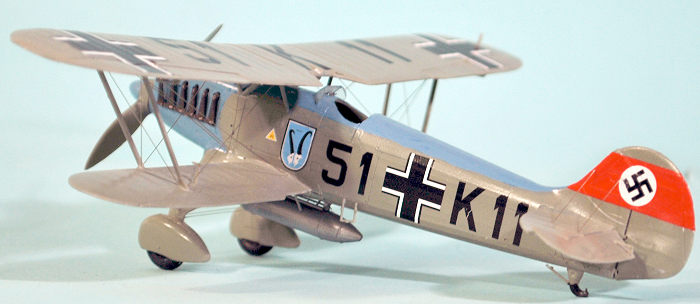 Assembly
was a breeze, and certainly far easier than my memory of the two Classic
Airframes kits I built. I prepainted the cockpit in RLM02 and then assembled
it and inserted the full assembly in the fuselage and closed it up. You have
a commendably-thin side flap, but I chose to close it up also to preserve
the overall lines. Anyone who puts effort into extra detail in the cockpit
will be happy to have that flap down.
Assembly
was a breeze, and certainly far easier than my memory of the two Classic
Airframes kits I built. I prepainted the cockpit in RLM02 and then assembled
it and inserted the full assembly in the fuselage and closed it up. You have
a commendably-thin side flap, but I chose to close it up also to preserve
the overall lines. Anyone who puts effort into extra detail in the cockpit
will be happy to have that flap down.
I glued in a sheet of plastic behind the holes for the engine exhaust, so that I would be able to later attach the “saxophone” exhausts individually so I did not have to paint around them.
I attached the horizontal stabilizers and then attached the separate rudder and elevators with the elevators drooped and the rudder kicked slightly to the side. I assembled the separate flaps on the lower wing up and the separate ailerons on the upper wing in the neutral postion. The landing gear fit easily and only needed a little clean up with the knife to get rid of the seam between inner ond outer parts.
| COLORS & MARKINGS |
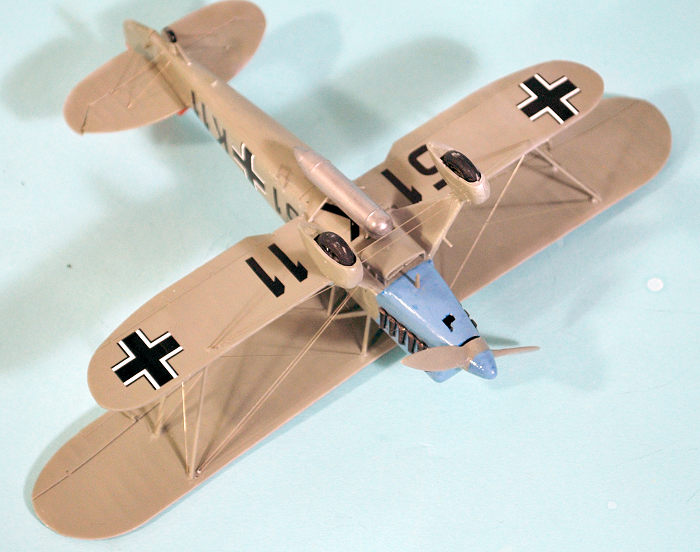 I
painted the light blue “Traditional Colour” which I mixed with Tamiya X-4
Blue” and X-2 “white”, then masked that off and painted the rest of the
model in RLM 63, another color I mixed from Tamiya RLM Grey and Buff.
I
painted the light blue “Traditional Colour” which I mixed with Tamiya X-4
Blue” and X-2 “white”, then masked that off and painted the rest of the
model in RLM 63, another color I mixed from Tamiya RLM Grey and Buff.
The decals from Aeromaster’s 48-456 “Birth of the Luftwaffe Part 1" went on without problem.
I used the Precision metals 0.2 mm nickel steel rod for the rigging. I then attached the windscreen and the drop tank.
| CONCLUSIONS |
The He-51 may have been a dog, but it was a good-looking mutt, and historically belongs in any 1930s aircraft collection of significant types. The Roden kit is the best one out there other than the very pricey Silver Wings 1/32 resin kit. Eduard has released this kit with their Bf-109E-1 as a limited release Spanish Civil War set with photoetch detail and great decals. If you like this airplane, that would be well worth the price. Highly recommended for Spanish Civil War, Luftwaffe and biplane fans.
Tom Cleaver
13 October 222 Copyright ModelingMadness.com. All rights reserved. No
reproduction in part or in whole without express permission. Kit courtesy the obscene profits I’m not
really making from my book sales.
If you would like your product reviewed fairly and fairly quickly, please contact the editor or see other details in the Note to Contributors.